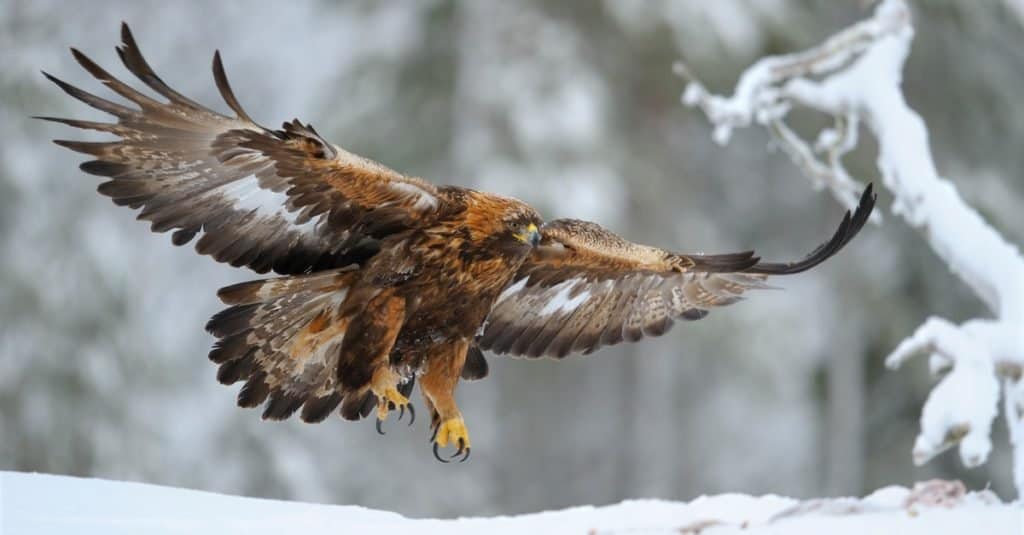Golden eagles are some of the most majestic birds in the world. They are massive, with wingspans larger than a man is tall. On top of their size, they are excellent hunters and are widely distributed across the world. Whether soaring in the air or perched on a ledge, these birds are a sight to see. Let’s take a closer look and learn: Golden Eagle Wingspan & Size: How Big Are They?
Golden eagle wingspan and size

Golden eagles have wingspans that can reach 7.7 feet in the wild.
©MehmetO/Shutterstock.com
Golden eagles are 33.1 inches tall and weigh up to 13.5 pounds, regardless of sex. Their wings are broad and long, much like a hawk’s (only bigger). A golden eagle’s wings span between 5.9 – 7.7 feet. Their average wingspan is 7.2 feet, putting them among the largest in North America. A female was banded in 207 in Teton National park and was officially weighed at 17 pounds, setting the record for wild-caught individuals.
In captivity, there have been larger individuals, often used in falconry. One bird was measured as weighing 27 pounds and had a wingspan of 9.25 feet. Birds used in falconry are specifically bred for size and weight, hence the size discrepancy with their wild counterparts.
Golden eagles are large birds with dark to light brown plumage (feathers). The feathers on the back of their neck and head have a slight golden sheen, giving them their name. They have white spots near their tail and on the wings when they are juvenile, but those turn brown as they age.
Where do golden eagles live?

Golden eagles prefer mountainous regions with sparse vegetation, but live almost everywhere.
©Vladimir Kogan Michael/Shutterstock.com
Golden eagles are the most widespread eagle in the world. They can be found as far north as Alaska, Siberia, and Norway, often preferring these sparse climates. In the United States, they are found as far south as Mexico and as far east as New England. In Asia, they are found across all of Russia and as far south as Manchuria in China. They are found in a few countries in Europe, notably Scandinavia, France, and Spain. Their most southernly ranges are found in Africa into Ethiopia.
Although they are found in almost every type of climate, golden eagles generally prefer open areas with vegetation. They don’t seem to like urban development and often seek out mountainous regions and craggy areas. The highest concentrations can be found in mountains, but they do appear in other locations. They can be found in scrublands near the arctic, taiga forests, evergreen forests, deserts, and semi-arid regions. Essentially, golden eagles can live in almost any environment.
In many regions, the golden eagle is migratory. They don’t often migrate in groups, but the largest group ever seen was in western Idaho when 124 of them were seen on a set of power lines. When the temperature drops, the eagles that face food shortages will head south until food is present again. Their migrations are often for breeding and food, not because they can’t handle it. Golden eagles are incredibly hardy birds that can live in almost any environment.
How far can a golden eagle fly?
With those massive wings, it’s no surprise that golden eagles can fly rather far distances. In a single day, they are known to travel up to 125 miles without landing. On a day-to-day basis, however, they travel much less than that. Their patroled territory is usually around 77 square miles, but that is mostly dependent on the availability of food.
When soaring in the air, a golden eagle can reach speeds of 30 mph. Tucking in their wings and diving, a golden eagle has been recorded going 200 mph, making them some of the fastest animals in the world. The peregrine falcon holds the record when it comes to speed, however, topping out at 240 mph.
Are golden eagles larger than bald eagles?

When it comes to flying birds in North America, the golden eagle is among the largest. In fact, it’s number four when it comes to sheer size. A common question, however, is whether they are larger than bald eagles. The numbers are close, but there is a winner, if only by a small margin.
Bald eagles are a single inch bigger than golden eagles when it comes to standing height. A golden eagle takes the edge in wingspan, even though it’s only by a half-inch. In weight, the golden eagle wins by the slim margin of .5 pounds. Overall, however, the golden eagle is significantly more powerful than the bald eagle. They are adapted to hunt terrestrial mammals, whereas the bald eagle is better at fishing. A bald eagle wouldn’t want to mess with a golden eagle!
What do golden eagles eat?
Golden eagles can use their immense power and flying skills to catch food that is bigger than they are. Their favorite foods are medium-sized mammals, things like hares, rabbits, squirrels, marmots, and rodents. Outside of their common foods, golden eagles have been seen killing and eating cranes, deer, and even some domestic livestock. Arctic foxes (in the northern regions) are also common prey.
Incredibly, golden eagles have been observed killing prey significantly bigger than them, often by knocking them off a cliff. They have been recorded killing seals, mountain goats, sheep, coyotes, and large cats. Aside from large prey, they are also proficient at catching fish.
Do golden eagles have any predators?
Generally, adult golden eagles don’t need to worry about predators. If threatened, they can just fly away, but there are few animals that would even want to mess with the razor-sharp beak and talons of an eagle. The most dangerous time for golden eagles is when they are chicks. Wolverines, foxes, and bears may kill them or steal eggs from a nest.
Smaller birds will group up in flocks to harass an eagle, however, especially if they are near a nest. This can occasionally be seen in rural settings with other raptors, especially hawks. The smaller birds will swarm the larger one, hoping to lead it away.
The photo featured at the top of this post is © Martin Mecnarowski/Shutterstock.com
Thank you for reading! Have some feedback for us? Contact the AZ Animals editorial team.






